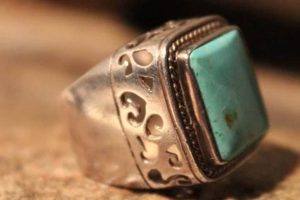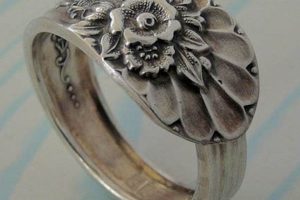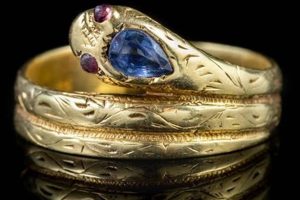A ring design drawing inspiration from past eras, such as Edwardian, Art Deco, or Victorian periods, often replicates characteristic design elements, materials, and techniques of those times. These rings evoke a sense of history and timeless elegance. An example includes a ring featuring milgrain detailing, a filigree setting, and a central Old European cut diamond, mirroring aesthetics popular in the early 20th century.
Such rings possess a unique allure and offer several advantages. They provide an alternative to contemporary styles, allowing individuals to express personal taste that leans toward classic or romantic aesthetics. Furthermore, they often showcase intricate craftsmanship and attention to detail, setting them apart from mass-produced designs. The historical context imbues the jewelry with a sense of provenance, making it a cherished heirloom with a story to tell.
The following sections will delve into specific design features, popular eras that influence the design, and considerations for selecting one that aligns with individual preferences and budgets. This exploration aims to provide a comprehensive understanding of these historically-inspired pieces.
Selecting a Ring with Historical Allure
Choosing a ring evocative of bygone eras necessitates careful consideration. The following points offer guidance for navigating the selection process and ensuring the acquisition of a piece that aligns with aesthetic preferences and value expectations.
Tip 1: Research Period Aesthetics: Familiarize yourself with the defining characteristics of specific eras, such as the geometric patterns of Art Deco or the delicate filigree of Edwardian designs. Understanding these nuances enables informed decisions.
Tip 2: Evaluate Metal Type and Condition: Inspect the metal for signs of wear and damage. Platinum and gold are common choices, but their condition will impact the ring’s longevity and overall appearance. Consider whether repairs or restoration may be necessary.
Tip 3: Assess Gemstone Authenticity and Cut: Verify the authenticity of gemstones, particularly diamonds. Antique cuts, such as Old European or Rose cuts, differ significantly from modern brilliant cuts and contribute to the ring’s period-specific appearance. Certificate is important for the authenticity.
Tip 4: Consider the Setting Style: The settingProng, Bezel, or Paveplays a crucial role in securing the gemstone and contributing to the ring’s overall aesthetic. Ensure the setting is secure and complements the gemstone.
Tip 5: Pay Attention to Detailing: Details such as milgrain edging, hand engraving, and filigree work significantly enhance a ring’s historical accuracy. Examine these details closely for quality and consistency.
Tip 6: Authenticity Verification: If possible, consult with a reputable jeweler specializing in estate or antique jewelry. They can provide insights into the ring’s origins and potential value.
Tip 7: Ensure Proper Sizing and Fit: Ensure the ring fits comfortably and securely. Sizing can affect the structural integrity of the ring, especially in delicate or intricate settings. Seek professional sizing services.
Adherence to these guidelines ensures the acquisition of a ring that possesses both aesthetic appeal and lasting value. Careful evaluation of materials, craftsmanship, and historical accuracy are paramount.
The subsequent sections will address the budgetary considerations and explore various vendor options for acquiring one with historical charm.
1. Era-Specific Designs
Era-specific designs form the bedrock of rings inspired by the past. The core concept of this style hinges on replicating or drawing inspiration from distinct historical periods, impacting every facet of the ring’s appearance and construction. The effect of emulating such eras extends beyond mere aesthetics; it imbues the piece with historical context and a narrative connection to a specific time. The selection of design elements drawn from particular eras directly contributes to the visual distinction between rings and contemporary counterparts.
For instance, a ring echoing the Art Deco era often features geometric patterns, bold lines, and step-cut gemstones, reflecting the period’s fascination with industrial progress and streamlined forms. Conversely, a ring inspired by the Edwardian era frequently incorporates delicate filigree, intricate metalwork, and flowing, organic motifs, mirroring the era’s romantic and elegant sensibilities. Without these era-specific design choices, the piece would lack the essential characteristic that defines it. A lack of period consideration renders a ring merely a generic piece, devoid of the historical allusions that make vintage inspired designs unique.
In summary, era-specific designs are not merely decorative additions. They are fundamental components that contribute to the ring’s authenticity, historical narrative, and visual distinctiveness. The challenge lies in accurately capturing the essence of an era while ensuring the ring remains structurally sound and wearable. Understanding this connection is practically significant for both consumers and designers, enabling informed choices and the creation of pieces that resonate with historical accuracy and stylistic integrity.
2. Intricate Craftsmanship
Intricate craftsmanship represents a defining characteristic frequently associated with ring designs emulating historical periods. This emphasis on detailed artistry elevates such pieces beyond mere jewelry, transforming them into miniature works of art. The quality of the craftsmanship directly affects the aesthetic appeal and the perceived value of the ring, underscoring its significance.
- Milgrain Detailing
Milgrain, a delicate beaded edge often seen on rings, requires precise application using specialized tools. Its presence adds a subtle texture and a refined finish, enhancing the ring’s visual complexity. Inauthentic or poorly executed milgrain diminishes the ring’s historical accuracy and perceived value, potentially appearing uneven or unfinished.
- Filigree Work
Filigree involves the creation of intricate patterns using fine wires, typically of gold or platinum. The process demands skilled hands and a keen eye for detail, resulting in delicate and visually captivating designs. The density and complexity of filigree directly correlate with the level of craftsmanship involved; subpar filigree may appear sparse, uneven, or lack structural integrity.
- Hand Engraving
Hand engraving involves the carving of designs directly onto the metal surface using specialized tools. This technique allows for the creation of highly personalized and intricate patterns, imparting a unique character to each ring. The depth and precision of the engraving are indicative of the artisan’s skill; shallow or uneven engraving detracts from the ring’s overall aesthetic.
- Setting Security
Beyond aesthetic considerations, intricate craftsmanship extends to the secure setting of gemstones. Prongs, bezels, and other setting styles must be meticulously crafted to ensure the stone is held firmly in place. Inadequate or poorly executed settings can compromise the stone’s security, increasing the risk of loss or damage. A secure setting is both a functional and an aesthetic imperative.
These facets of intricate craftsmanship collectively contribute to the creation of rings that evoke a sense of historical authenticity and artistic merit. The presence of well-executed milgrain, filigree, hand engraving, and secure settings elevates a ring beyond a simple piece of jewelry, transforming it into a testament to the skill and artistry of the craftsperson. The absence of these elements, or their poor execution, diminishes the ring’s value and historical appeal.
3. Gemstone Characteristics
The selection and attributes of gemstones are integral to designs aiming to replicate or evoke earlier eras. The visual impact, historical accuracy, and overall value depend significantly on the gemstone’s cut, clarity, color, and carat weight, aligning with the specific period being emulated.
- Diamond Cut Styles
Cut styles significantly diverge across historical periods. The Old European cut, prevalent in the late 19th and early 20th centuries, features a higher crown, deeper pavilion, and a smaller table than modern brilliant cuts. Rose cuts, with their flat base and faceted dome, were popular in earlier centuries. The choice of diamond cut profoundly affects the light performance and visual aesthetic of the ring. A modern brilliant cut in a ring intended to evoke the Edwardian era would be incongruous, diminishing its historical accuracy.
- Gemstone Color Grading
The perception of color in gemstones has evolved over time. While colorless diamonds are prized today, slightly tinted diamonds were often used historically. The emphasis on perfectly colorless stones is a relatively recent phenomenon. Furthermore, colored gemstones, such as sapphires, rubies, and emeralds, exhibit variations in color intensity and saturation that reflect different geological origins and cutting techniques. Understanding these nuances is essential for selecting gemstones that align with the intended historical aesthetic.
- Clarity Characteristics
Clarity refers to the absence of inclusions and blemishes within a gemstone. While flawless gemstones command the highest prices, minor inclusions were more commonly accepted and even appreciated in historical settings. These inclusions, sometimes referred to as “internal characteristics,” can serve as identifying markers, confirming the gemstone’s natural origin. A focus on absolute clarity, while desirable, may not be historically accurate for rings aiming to emulate older styles.
- Gemstone Sourcing and Origin
The geographic origin of gemstones can also contribute to their historical significance. For example, sapphires from Kashmir, rubies from Burma (Myanmar), and diamonds from Golconda (India) were highly prized and frequently used in jewelry during specific periods. The provenance of a gemstone, while often difficult to verify definitively, can add to its allure and historical narrative.
In summary, careful consideration of gemstone cut, color, clarity, and origin is paramount in achieving an accurate representation of a historical aesthetic. A deliberate selection process, informed by an understanding of historical preferences and gemstone characteristics, contributes significantly to the authenticity and value of a “vintage style engagement ring.” These elements collectively determine the ring’s ability to evoke a sense of history and timeless elegance.
4. Metal Composition
Metal composition is a critical determinant of both the aesthetic and structural integrity of a ring seeking to emulate historical styles. The choice of metal significantly influences the ring’s color, durability, and overall appearance, contributing directly to its perceived authenticity. Furthermore, different metals were favored during various historical periods, impacting the selection process. Therefore, understanding metal composition and its historical context is paramount when assessing a vintage-inspired engagement ring.
For instance, platinum became increasingly popular in the early 20th century, particularly during the Edwardian and Art Deco periods. Its strength and malleability allowed for intricate designs and secure settings for diamonds. Rings from these eras frequently feature platinum shanks and settings, often combined with white gold accents. Conversely, yellow gold was more prevalent in earlier periods, such as the Victorian era. Rings designed to evoke these earlier aesthetics often incorporate yellow gold, sometimes with rose gold accents to create a warm, romantic feel. The alloy composition of the gold also matters. Lower karat gold alloys (e.g., 10k or 14k) are more durable due to the presence of other metals, but they lack the richness of color associated with higher karat alloys (e.g., 18k or 22k). The choice of metal and its alloy is not merely a matter of preference; it’s a deliberate design decision with historical implications and practical considerations.
Ultimately, the suitability of a particular metal composition for a rings depends on balancing aesthetic goals with structural requirements. Careful consideration of historical precedent and the properties of different metals ensures the selection of materials that not only capture the essence of the desired era but also provide the ring with the durability necessary for lasting wear. Challenges arise when modern alloys are used to emulate antique styles, as these can sometimes lack the subtle nuances of color and texture found in older materials. A thorough understanding of metal composition remains essential for discerning the quality and authenticity of any ring with historical aspirations.
5. Setting Integrity
Setting integrity in rings imitating historic designs is not merely a structural concern; it is a pivotal element dictating the long-term preservation of both the gemstone and the ring’s aesthetic. The setting secures the gemstone and directly influences the ring’s visual coherence, contributing to its overall authenticity. Compromised setting integrity leads to a heightened risk of gemstone loss or damage, undermining the ring’s value and negating its historical allusions. For example, a prong setting replicating an Edwardian design may fail if the prongs are too thin or improperly aligned, resulting in the diamond’s displacement. Similarly, a bezel setting attempting to mimic Art Deco styles may lose its ability to protect the stone if the metal is too soft or poorly soldered, leading to chipping or cracking. The setting’s integrity, therefore, serves as a critical line of defense, preventing both physical damage and the erosion of the ring’s historical character.
The practical implications of understanding setting integrity are numerous. Purchasers of rings echoing historical designs must meticulously examine the setting for signs of weakness, wear, or improper construction. Jewelers specializing in estate or vintage jewelry can provide expert assessments of setting security and identify potential vulnerabilities. Restoration or repair of settings requires specialized skills and materials to ensure both structural soundness and historical accuracy. Failure to address setting integrity issues can result in costly gemstone replacement or irreversible damage to the ring’s overall aesthetic. The setting contributes not only to the piece’s structural integrity but also its historical narrative. When the setting is appropriate and expertly crafted, the ring accurately reflects its design inspiration. The prongs, bezels, or other setting styles are secured with the stones and complement the overall setting.
In conclusion, the integrity of the setting is indispensable for preserving the aesthetic and value of rings evocative of earlier times. A compromised setting can lead to gemstone loss, damage, and a diminished historical appearance. Rigorous inspection, expert assessment, and skilled restoration are essential for maintaining setting integrity and ensuring these timeless pieces endure as both functional adornments and authentic reflections of the past. The challenge lies in balancing aesthetic faithfulness with structural robustness, requiring a blend of historical knowledge and technical expertise. The setting is also to determine if it meets personal style preferences.
Frequently Asked Questions
The following section addresses common inquiries regarding rings inspired by designs from bygone eras. The information presented aims to clarify potential misconceptions and provide a comprehensive understanding of these historically-inspired pieces.
Question 1: What distinguishes a ring inspired by a previous era from a genuine antique?
A ring designed to mimic earlier periods is newly manufactured, incorporating design elements from specific eras. A genuine antique ring is an original piece created during the period it represents. The distinction lies in the date of creation and material aging.
Question 2: Are rings inspired by former eras less valuable than authentic antique pieces?
Generally, yes. The value of an authentic antique ring derives from its age, rarity, and historical provenance. rings mimicking historic designs are valued primarily for their materials, craftsmanship, and aesthetic appeal, not their historical significance.
Question 3: What are the most prevalent eras that influence designs?
Commonly emulated eras include the Victorian, Edwardian, Art Nouveau, and Art Deco periods. Each era possesses distinct characteristics in terms of metalwork, gemstone cuts, and design motifs.
Question 4: Are modern gemstones used in rings imitating historical aesthetics?
Yes, modern gemstones can be incorporated. However, to maintain historical accuracy, jewelers often utilize antique-cut gemstones, such as Old European or Rose cuts, which are recut to resemble those used in previous eras.
Question 5: How can one assess the quality of a ring with historical aspirations?
Quality assessment involves examining the intricacy of the metalwork, the precision of the gemstone settings, the authenticity of the gemstone cuts, and the overall craftsmanship. Consultation with a reputable jeweler specializing in estate or rings is recommended.
Question 6: Are rings inspired by historic eras more susceptible to damage than contemporary styles?
The susceptibility to damage depends on the design and materials used. Delicate filigree work or intricate settings may be more vulnerable to impact or wear. Regular maintenance and careful handling are essential to preserve their integrity.
In summary, designs evoking former eras offer an alternative to contemporary styles, allowing individuals to express a preference for classic aesthetics. However, understanding the distinctions between authentic antiques and new creations, as well as the nuances of quality assessment, is crucial for informed decision-making.
The subsequent section will explore vendor options and budgetary considerations for acquiring historically-inspired jewelry.
Conclusion
The preceding exploration has examined the multifaceted nature of the “vintage style engagement ring.” This design approach encompasses era-specific aesthetics, intricate craftsmanship, characteristic gemstones, metal composition considerations, and the critical importance of setting integrity. Each element contributes significantly to the overall authenticity and lasting value of these historically-inspired pieces.
Selecting a “vintage style engagement ring” requires informed discernment. The pursuit of pieces which authentically reflect historical periods, while also ensuring structural soundness and timeless appeal, remains paramount. Future trends may see increased emphasis on sustainable sourcing of materials and the incorporation of advanced techniques to replicate historic designs with greater precision.







